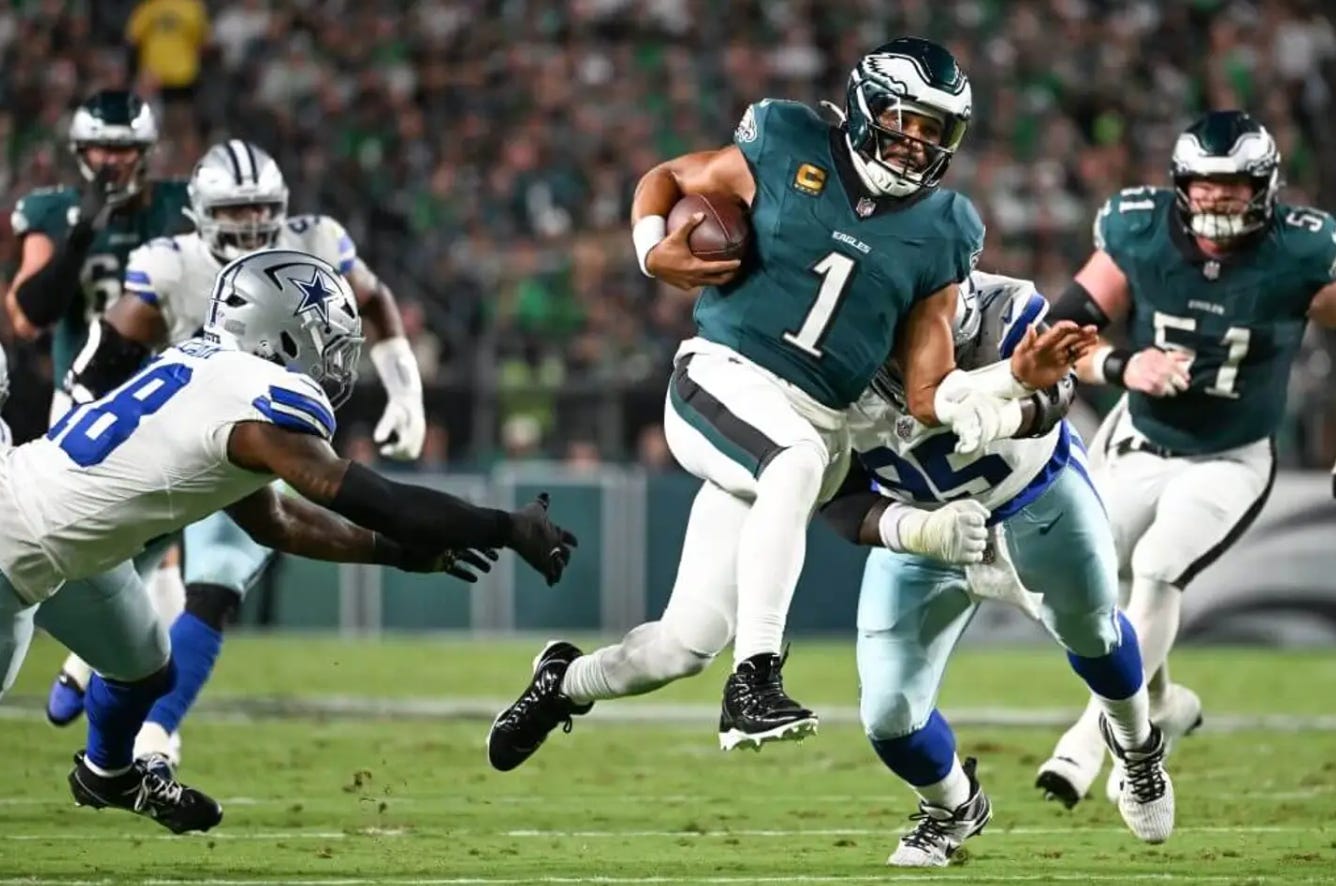Week 1 TNF Eagles-Cowboys: Advanced Review
The defending champs take care of business at home, though leaving the door open for a Cowboys team that could score in the second half
The adjusted scores quantify team play quality, with emphasis on stable metrics (success rate) and downplaying higher variance events (turnovers, special team, penalties, fumble luck, etc). Adjusted expected points added (EPA), in conjunction with opportunity-based metrics like total plays and drives, projects adjusted points. Adjusted scores have been tested against actual scores and offer slightly better predictive ability, though their primary benefit is explanatory.
All 2025-2022 and historical Adjusted Scores and other site metrics are available in a downloadable format to paid subscribers via Google Sheet.
Find previous advanced reviews here
** Adjusted Scores table:
“Pass” - Pass rate over expectation (based on context of each play and historical averages
“Success” - Success rate on offense, a key metric in adjusted score vs actual
“H & A” - Home or away team
PHI (-8.5) vs DAL
The adjusted scores saw this game as a bit more narrow than the actual scores. Both teams’ offenses performed at strong success rates, but the Philadelphia Eagles were able to convert one more of their scoring drives to a touchdown. As you see below in the game’s most impactful plays, the Eagles +5.8-point turnover advantage came from the biggest EPA swing play - the game’s only turnover.
Early in the third quarter, it looked as if neither defense would be able to get a stop all night, with the game’s first eight drives leading to scores, and the Cowboys positioned on the next drive to score at least a touchdown. Then came the Miles Sanders fumble (-5.8 EPA) and shortly thereafter a 1 hour and 4 minute thunder delay. Whether coincidental or momentum killing (I vote for mostly the former), neither team scored on their final seven post-delay drives.
The Cowboys were highly successful running the ball against the Eagles, hitting the 73rd percentile in rushing efficiency (116 yards and two touchdowns on 21 designed runs, +0.05 EPA per), despite losing 5.8 EPA on the Sanders fumble. The harm Sanders caused by the fumble was somewhat mitigated by the 49 yards gained on the prior play (+3.7 EPA).
The Cowboys offensive and Eagles defensive numbers should be viewed with the context that the Eagles lost interior defender Jalen Carter before the first snap of the game, following a strange spitting incident and ejection. Although Carter graded significantly stronger last season as a pass rusher (81.5, 5th at the position) than run defender (59.0, 32nd), according to PFF.
The Eagles posted both strong dropback and designed run efficiencies. Saquon Barkley surprisingly was the lone drag on the Eagles rushing value, losing 1.2 expected points (60 yards and a touchdown on 16 carries).
The Eagles pass rate versus expectation (“Pass (H)” above) was only -0.6%, even though their box score shows 23 pass attempts and 38 runs. I classify all dropbacks as called passes, and Jalen Hurts turned 10 dropbacks into scrambles, gaining a massive 66 yards and two touchdowns (+6.4 EPA).
Both quarterbacks played well and added value, though in very different ways. As mentioned above, Hurts was a scrambling machine, also adding in a couple successful tush pushes on 3rd & 1’s. He was accurate (19/23, +21.8% completion percentage over expected), but rarely stretched the field, outside of a 51-yard completion to Jahan Dotson on 3rd & 6 in the late second quarter. Hurts finished with a paltry 4.9-yard average depth of target, with elite receiver A.J. Brown notably targeted just once - an eight-yard completion in the waning moments of the game.
Dak Prescott looked much more impressive by the advanced stats than his pedestrian box score: +5.7 EPA versus 21/24, 188 yards and no touchdowns. Prescott boosted his numbers with key third down conversions early in the game, and his traditional box score ignores a 32-yard defensive pass interference gain (+3.2 EPA) on 2nd & 23 targeting George Pickens. Prescott was completely clean from a mistakes perspective, with zero turnovers and didn’t take any sacks.








This game was lost in Dallas's inability to pass on first and second down, specifically in the second half. For the entire game, they're only at a 32 percent success rate on first and second, so it's not specifically a second half problem, but after the halftime break, the Cowboys had only two successful early down passing plays ahead of them for the entire rest of the game. It's tough to score that way. It put a strain on their rush game too. I don't believe any of Dallas's last three drives featured a positive EPA run play, although there may be one. I don't remember exactly.
Nevertheless, whether it's one or zero successful rushes, it's tough to score with the effects of the struggle to pass on early downs and the resulting effect of having no rush game on early downs either. It takes a lot of third down prowess. Dallas did have a lot of that in this game, but not enough to score a single point in the second half. The 49 yard run (which I believe to be Dallas's final positive EPA rush play of this game) should've bailed them out, but with the big fumble, it didn't, and the Cowboys showed no ability at all to put a sustained attack, rush or pass, together after that.
At the top level, this looks like a positive game for a Dallas team that were 8.5 point underdogs coming in, but struggling to pass on first and second down is a scary thing, because a 58 percent success rate rushing on first and second down will not continue. This is all an overreaction to the first game of the season of course, but I get the sense Dallas fans are being a bit too positive about a game that relied a lot on successful third down plays.